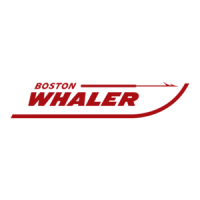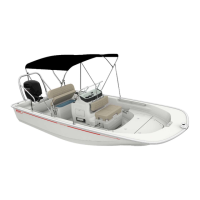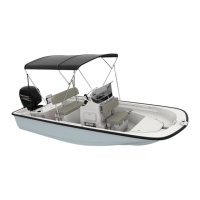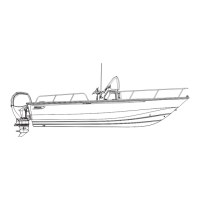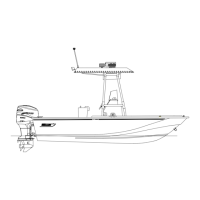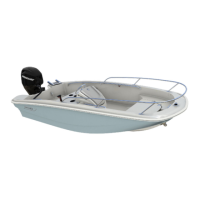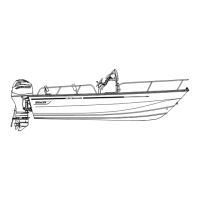
Do you have a question about the Boston Whaler 190 Montauk and is the answer not in the manual?
| Beam | 8' 0" |
|---|---|
| Weight | 1, 900 lbs |
| Maximum Horsepower | 150 HP |
| Seating Capacity | 8 |
| Weight (Dry) | 1, 900 lbs |
| Deadrise at Transom | 16° |
| Beam (Third Value) | 8' 0" |
| Weight (Third Value) | 1, 900 lbs |
| Fuel Capacity | 60 gal |
| Fuel Capacity (Second Value) | 60 gal |
| Length Overall | 19' 4" |
Details the content and purpose of the owner's manual.
Outlines the operator's duties for safe boating and boat handling.
Lists resources for obtaining boating safety courses and information.
Explains component warranties included with the boat.
Provides contact phone numbers and internet addresses for assistance.
Covers structural hull defects for 0-5 and 5-10 years.
Details warranty for accessories manufactured and installed by Boston Whaler.
Defines the exclusive remedy and disclaims other warranties.
Specifies the legal time limits for rescission or revocation claims.
Outlines the process for initiating a warranty claim.
Instructions for registering the new boat.
Details on transferring the boat's limited warranty to a new owner.
Explains safety precautions, hazard symbols (Danger, Warning, Caution, Notice).
Defines safe boating principles and how to acquire skills.
Provides checklists for before departure, trailering, and after return.
Lists minimum required safety equipment by U.S. Coast Guard.
Covers PFD requirements, types, and usage guidelines.
Recommends fire extinguishers and locations for safety.
Details requirements for whistles, horns, and visual distress signals.
Warns against operating a boat under the influence of alcohol or drugs.
Explains CO dangers, symptoms, and prevention measures.
Discusses the importance of PFDs for preventing drowning.
Provides safety guidelines for boarding the boat.
Emphasizes operator awareness and proper boat handling techniques.
Covers boat handling, passenger safety, and fuel rules.
Guides for medical emergencies, water rescue, and fire response.
Procedures for responding to flooding, swamping, and capsizing events.
Actions for collisions and propulsion/steering system failures.
Advice on grounding and required distress signals.
Guidance on radio use for emergencies and weather awareness.
Safety guidelines for swimming, diving, and water skiing.
Standard hand signals for communication during water skiing.
Operation and importance of the engine shutdown safety switch.
Importance of float plans and charting courses.
Covers fuel spills, noise, and homeland security restrictions.
Identifies locations and importance of warning labels on the boat.
Details construction standards, Unibond™ hull, and HIN.
Recommends authorized service and explains certification plates.
Defines boat design categories based on operating conditions.
Guidance on maximum engine power and weight capacity.
Lists overall dimensions, clearances, and key specifications.
Defines safe areas for passengers and deck usage rules.
Identifies the location of various through-hull fittings on the boat.
Lists and illustrates key features and optional equipment.
Details components and layout of the helm and control station.
Explains the control station switch panel and seating/storage areas.
Guides for using the gear shift, throttle, and power trim/tilt.
Explains the operation and importance of navigation and anchor lights.
Information on the steering system and optional trolling motor.
Details propeller characteristics, selection, and replacement advice.
Covers docking, lifting points, and securing the boat for trailering.
Guidelines for trailer safety, securing the boat, and hitch requirements.
Information on trailer disc brake systems and maintenance.
Identifies trailer components and pre-towing safety checks.
Explains the operation, maintenance, and troubleshooting of the bilge pump.
Details the gasoline fuel system, including fill, vent, and tank.
Safety precautions to prevent static discharge during fueling.
Information on using ethanol fuels, phase separation, and additives.
Discusses fuel filters, maintenance, and long-term fuel storage.
Procedure for starting the engine safely and warming it up.
Procedure for safely shutting down the engine.
Instructions for operating and maintaining the livewell system.
Guidance on considerations, rode, scope, and proper anchoring.
Steps for lowering, setting, and weighing the anchor.
Requirements and installation of the anchor light.
Details the boat's DC electrical system powered by a single battery.
Guidance on battery storage, safety, and maintenance.
Location and function of the main DC breaker and component circuit breakers.
Description of the 12V accessory receptacle and its usage.
Explains how to operate the battery selector switch (CE Option).
Details on trolling motor receptacles and wiring connections.
Information on electrical schematics, harnesses, and wire identification.
Diagram illustrating the switch and breaker panel layout.
Guidance on cleaning the hull, windshield, and stainless steel trim.
Discusses preventing and treating hull blisters.
Steps and considerations for painting the boat's hull bottom.
Instructions for cleaning and maintaining vinyl cushions.
Guidelines for storing the boat, engine, and fuel system.
Advice on storing the trailer and boat battery.
Instructions for cleaning and maintaining canvas items.
A logbook to record scheduled service and maintenance performed.

